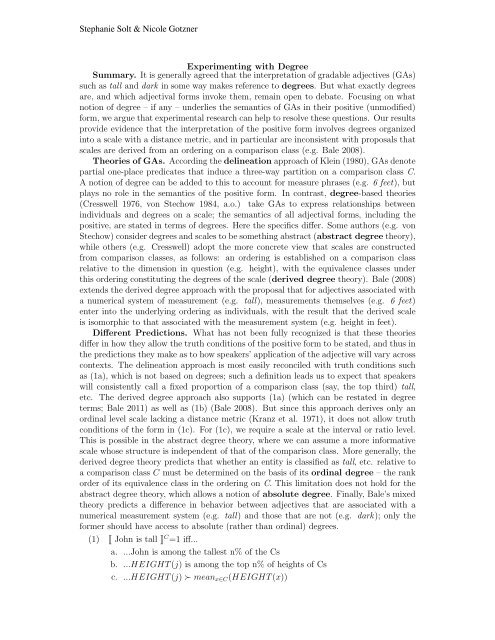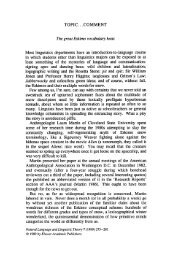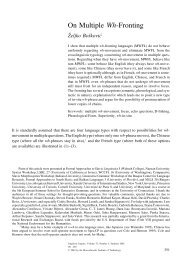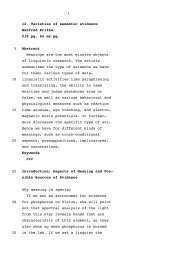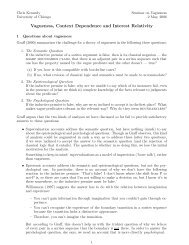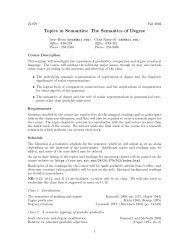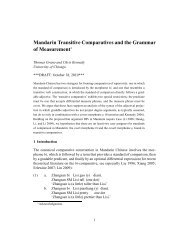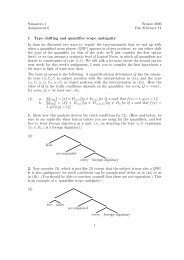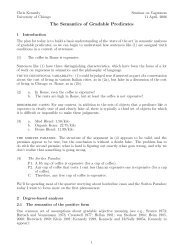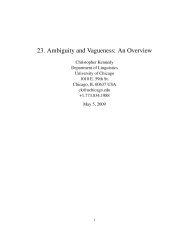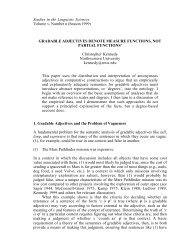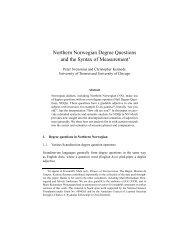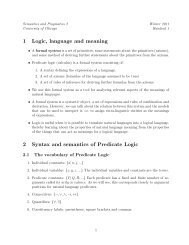On the natural history of negative polarity items - Syntax, Semantics ...
On the natural history of negative polarity items - Syntax, Semantics ...
On the natural history of negative polarity items - Syntax, Semantics ...
You also want an ePaper? Increase the reach of your titles
YUMPU automatically turns print PDFs into web optimized ePapers that Google loves.
Stephanie Solt & Nicole Gotzner<br />
Experimenting with Degree<br />
Summary. It is generally agreed that <strong>the</strong> interpretation <strong>of</strong> gradable adjectives (GAs)<br />
such as tall and dark in some way makes reference to degrees. Butwhatexactlydegrees<br />
are, and which adjectival forms invoke <strong>the</strong>m, remain open to debate. Focusing on what<br />
notion <strong>of</strong> degree – if any – underlies <strong>the</strong> semantics <strong>of</strong> GAs in <strong>the</strong>ir positive (unmodified)<br />
form, we argue that experimental research can help to resolve <strong>the</strong>se questions. Our results<br />
provide evidence that <strong>the</strong> interpretation <strong>of</strong> <strong>the</strong> positive form involves degrees organized<br />
into a scale with a distance metric, and in particular are inconsistent with proposals that<br />
scales are derived from an ordering on a comparison class (e.g. Bale 2008).<br />
Theories <strong>of</strong> GAs. According <strong>the</strong> delineation approach <strong>of</strong> Klein (1980), GAs denote<br />
partial one-place predicates that induce a three-way partition on a comparison class C.<br />
Anotion<strong>of</strong>degreecanbeaddedtothistoaccountformeasurephrases(e.g. 6feet), but<br />
plays no role in <strong>the</strong> semantics <strong>of</strong> <strong>the</strong> positive form. In contrast, degree-based <strong>the</strong>ories<br />
(Cresswell 1976, von Stechow 1984, a.o.) take GAs to express relationships between<br />
individuals and degrees on a scale; <strong>the</strong> semantics <strong>of</strong> all adjectival forms, including <strong>the</strong><br />
positive, are stated in terms <strong>of</strong> degrees. Here <strong>the</strong> specifics differ. Some authors (e.g. von<br />
Stechow) consider degrees and scales to be something abstract (abstract degree <strong>the</strong>ory),<br />
while o<strong>the</strong>rs (e.g. Cresswell) adopt <strong>the</strong> more concrete view that scales are constructed<br />
from comparison classes, as follows: an ordering is established on a comparison class<br />
relative to <strong>the</strong> dimension in question (e.g. height), with <strong>the</strong> equivalence classes under<br />
this ordering constituting <strong>the</strong> degrees <strong>of</strong> <strong>the</strong> scale (derived degree <strong>the</strong>ory). Bale (2008)<br />
extends <strong>the</strong> derived degree approach with <strong>the</strong> proposal that for adjectives associated with<br />
anumericalsystem<strong>of</strong>measurement(e.g. tall), measurements <strong>the</strong>mselves (e.g. 6feet)<br />
enter into <strong>the</strong> underlying ordering as individuals, with <strong>the</strong> result that <strong>the</strong> derived scale<br />
is isomorphic to that associated with <strong>the</strong> measurement system (e.g. height in feet).<br />
Different Predictions. What has not been fully recognized is that <strong>the</strong>se <strong>the</strong>ories<br />
differ in how <strong>the</strong>y allow <strong>the</strong> truth conditions <strong>of</strong> <strong>the</strong> positive form to be stated, and thus in<br />
<strong>the</strong> predictions <strong>the</strong>y make as to how speakers’ application <strong>of</strong> <strong>the</strong> adjective will vary across<br />
contexts. The delineation approach is most easily reconciled with truth conditions such<br />
as (1a), which is not based on degrees; such a definition leads us to expect that speakers<br />
will consistently call a fixed proportion <strong>of</strong> a comparison class (say, <strong>the</strong> top third) tall,<br />
etc. The derived degree approach also supports (1a) (which can be restated in degree<br />
terms; Bale 2011) as well as (1b) (Bale 2008). But since this approach derives only an<br />
ordinal level scale lacking a distance metric (Kranz et al. 1971), it does not allow truth<br />
conditions <strong>of</strong> <strong>the</strong> form in (1c). For (1c), we require a scale at <strong>the</strong> interval or ratio level.<br />
This is possible in <strong>the</strong> abstract degree <strong>the</strong>ory, where we can assume a more informative<br />
scale whose structure is independent <strong>of</strong> that <strong>of</strong> <strong>the</strong> comparison class. More generally, <strong>the</strong><br />
derived degree <strong>the</strong>ory predicts that whe<strong>the</strong>r an entity is classified as tall, etc.relativeto<br />
acomparisonclassC must be determined on <strong>the</strong> basis <strong>of</strong> its ordinal degree – <strong>the</strong> rank<br />
order <strong>of</strong> its equivalence class in <strong>the</strong> ordering on C. Thislimitationdoesnotholdfor<strong>the</strong><br />
abstract degree <strong>the</strong>ory, which allows a notion <strong>of</strong> absolute degree. Finally,Bale’smixed<br />
<strong>the</strong>ory predicts a difference in behavior between adjectives that are associated with a<br />
numerical measurement system (e.g. tall) andthosethatarenot(e.g. dark); only <strong>the</strong><br />
former should have access to absolute (ra<strong>the</strong>r than ordinal) degrees.<br />
(1) John is tall C =1 iff...<br />
a. ...John is among <strong>the</strong> tallest n% <strong>of</strong> <strong>the</strong> Cs<br />
b. ...HEIGHT(j) isamong<strong>the</strong>topn%<strong>of</strong>heights<strong>of</strong>Cs<br />
c. ...HEIGHT(j) ≻ meanx∈C(HEIGHT(x))


